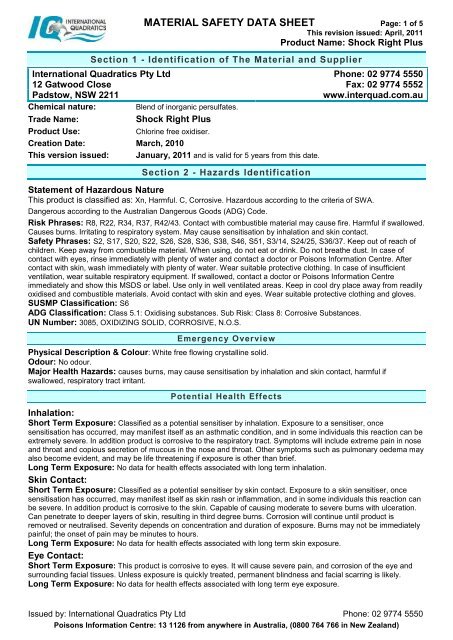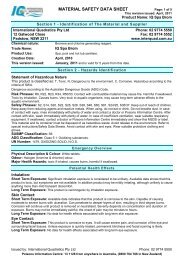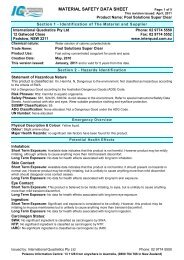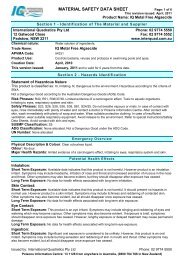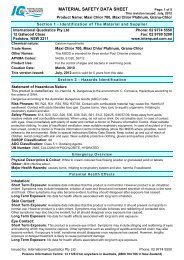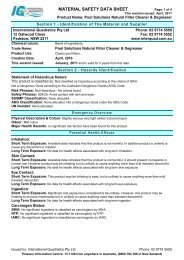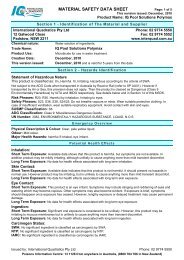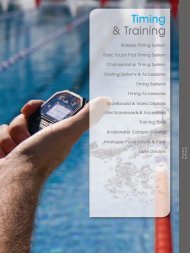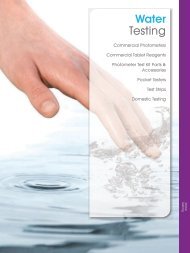IQ Spa Solutions Shock Right Plus
IQ Spa Solutions Shock Right Plus
IQ Spa Solutions Shock Right Plus
You also want an ePaper? Increase the reach of your titles
YUMPU automatically turns print PDFs into web optimized ePapers that Google loves.
MATERIAL SAFETY DATA SHEET Page: 1 of 5<br />
This revision issued: April, 2011<br />
Product Name: <strong>Shock</strong> <strong>Right</strong> <strong>Plus</strong><br />
Section 1 - Identification of The Material and Supplier<br />
International Quadratics Pty Ltd Phone: 02 9774 5550<br />
12 Gatwood Close Fax: 02 9774 5552<br />
Padstow, NSW 2211<br />
www.interquad.com.au<br />
Chemical nature:<br />
Blend of inorganic persulfates.<br />
Trade Name:<br />
<strong>Shock</strong> <strong>Right</strong> <strong>Plus</strong><br />
Product Use:<br />
Chlorine free oxidiser.<br />
Creation Date: March, 2010<br />
This version issued: January, 2011 and is valid for 5 years from this date.<br />
Section 2 - Hazards Identification<br />
Statement of Hazardous Nature<br />
This product is classified as: Xn, Harmful. C, Corrosive. Hazardous according to the criteria of SWA.<br />
Dangerous according to the Australian Dangerous Goods (ADG) Code.<br />
Risk Phrases: R8, R22, R34, R37, R42/43. Contact with combustible material may cause fire. Harmful if swallowed.<br />
Causes burns. Irritating to respiratory system. May cause sensitisation by inhalation and skin contact.<br />
Safety Phrases: S2, S17, S20, S22, S26, S28, S36, S38, S46, S51, S3/14, S24/25, S36/37. Keep out of reach of<br />
children. Keep away from combustible material. When using, do not eat or drink. Do not breathe dust. In case of<br />
contact with eyes, rinse immediately with plenty of water and contact a doctor or Poisons Information Centre. After<br />
contact with skin, wash immediately with plenty of water. Wear suitable protective clothing. In case of insufficient<br />
ventilation, wear suitable respiratory equipment. If swallowed, contact a doctor or Poisons Information Centre<br />
immediately and show this MSDS or label. Use only in well ventilated areas. Keep in cool dry place away from readily<br />
oxidised and combustible materials. Avoid contact with skin and eyes. Wear suitable protective clothing and gloves.<br />
SUSMP Classification: S6<br />
ADG Classification: Class 5.1: Oxidising substances. Sub Risk: Class 8: Corrosive Substances.<br />
UN Number: 3085, OXIDIZING SOLID, CORROSIVE, N.O.S.<br />
Emergency Overview<br />
Physical Description & Colour: White free flowing crystalline solid.<br />
Odour: No odour.<br />
Major Health Hazards: causes burns, may cause sensitisation by inhalation and skin contact, harmful if<br />
swallowed, respiratory tract irritant.<br />
Potential Health Effects<br />
Inhalation:<br />
Short Term Exposure: Classified as a potential sensitiser by inhalation. Exposure to a sensitiser, once<br />
sensitisation has occurred, may manifest itself as an asthmatic condition, and in some individuals this reaction can be<br />
extremely severe. In addition product is corrosive to the respiratory tract. Symptoms will include extreme pain in nose<br />
and throat and copious secretion of mucous in the nose and throat. Other symptoms such as pulmonary oedema may<br />
also become evident, and may be life threatening if exposure is other than brief.<br />
Long Term Exposure: No data for health effects associated with long term inhalation.<br />
Skin Contact:<br />
Short Term Exposure: Classified as a potential sensitiser by skin contact. Exposure to a skin sensitiser, once<br />
sensitisation has occurred, may manifest itself as skin rash or inflammation, and in some individuals this reaction can<br />
be severe. In addition product is corrosive to the skin. Capable of causing moderate to severe burns with ulceration.<br />
Can penetrate to deeper layers of skin, resulting in third degree burns. Corrosion will continue until product is<br />
removed or neutralised. Severity depends on concentration and duration of exposure. Burns may not be immediately<br />
painful; the onset of pain may be minutes to hours.<br />
Long Term Exposure: No data for health effects associated with long term skin exposure.<br />
Eye Contact:<br />
Short Term Exposure: This product is corrosive to eyes. It will cause severe pain, and corrosion of the eye and<br />
surrounding facial tissues. Unless exposure is quickly treated, permanent blindness and facial scarring is likely.<br />
Long Term Exposure: No data for health effects associated with long term eye exposure.<br />
Issued by: International Quadratics Pty Ltd Phone: 02 9774 5550<br />
Poisons Information Centre: 13 1126 from anywhere in Australia, (0800 764 766 in New Zealand)
MATERIAL SAFETY DATA SHEET Page: 2 of 5<br />
This revision issued: April, 2011<br />
Product Name: <strong>Shock</strong> <strong>Right</strong> <strong>Plus</strong><br />
Ingestion:<br />
Short Term Exposure: Significant oral exposure is considered to be unlikely. Available data shows that this<br />
product is harmful, but symptoms are not available. However, this product is corrosive to the gastrointestinal tract.<br />
Capable of causing moderate to severe burns with ulceration. Can penetrate to deeper layers of skin, resulting in third<br />
degree burns. Corrosion will continue until product is removed or neutralised. Severity depends on concentration and<br />
duration of exposure.<br />
Long Term Exposure: No data for health effects associated with long term ingestion.<br />
Carcinogen Status:<br />
SWA: No significant ingredient is classified as carcinogenic by SWA.<br />
NTP: No significant ingredient is classified as carcinogenic by NTP.<br />
IARC: No significant ingredient is classified as carcinogenic by IARC.<br />
Section 3 - Composition/Information on Ingredients<br />
Ingredients CAS No Conc,% TWA (mg/m 3 ) STEL (mg/m 3 )<br />
Potassium peroxymonosulphate 70693-62-8 50 approx not set not set<br />
Sodium persulfate 7775-27-1 50 approx 0.01 Peak<br />
This is a commercial product whose exact ratio of components may vary slightly. Minor quantities of other non<br />
hazardous ingredients are also possible.<br />
The SWA TWA exposure value is the average airborne concentration of a particular substance when calculated over a normal 8 hour working day<br />
for a 5 day working week. The STEL (Short Term Exposure Limit) is an exposure value that may be equalled (but should not be exceeded) for no<br />
longer than 15 minutes and should not be repeated more than 4 times per day. There should be at least 60 minutes between successive exposures<br />
at the STEL. The term "peak "is used when the TWA limit, because of the rapid action of the substance, should never be exceeded, even briefly.<br />
General Information:<br />
Section 4 - First Aid Measures<br />
You should call The Poisons Information Centre if you feel that you may have been poisoned, burned or irritated by<br />
this product. The number is 13 1126 from anywhere in Australia (0800 764 766 in New Zealand) and is available at all<br />
times. Have this MSDS with you when you call.<br />
Inhalation: If inhalation occurs, contact a Poisons Information Centre, or call a doctor at once. Remove source of<br />
contamination or move victim to fresh air. If breathing is difficult, oxygen may be beneficial if administered by trained<br />
personnel, preferably on a doctor's advice. DO NOT allow victim to move about unnecessarily. Symptoms of<br />
pulmonary oedema can be delayed up to 48 hours after exposure.<br />
Skin Contact: Quickly and gently brush away excess solids. Seek immediate medical attention. Remove<br />
contaminated clothing, shoes and leather goods (e.g. watchbands, belts). Flush contaminated area with lukewarm,<br />
gently flowing water for at least 20-30 minutes, by the clock. DO NOT INTERRUPT FLUSHING. If necessary, keep<br />
emergency vehicle waiting (show paramedics this MSDS and take their advice). If irritation persists, repeat flushing.<br />
Seek medical attention.<br />
Eye Contact: Quickly and gently brush particles from eyes. Immediately flush the contaminated eye(s) with<br />
lukewarm, gently flowing water for at least 20-30 minutes, by the clock, while holding the eyelid(s) open. Neutral<br />
saline solution may be used as soon as it is available. DO NOT INTERRUPT FLUSHING. If necessary, keep<br />
emergency vehicle waiting (show paramedics this MSDS and take their advice). Take care not to rinse contaminated<br />
water into the unaffected eye or onto face. If irritation persists, repeat flushing. Call a Poisons Information Centre or a<br />
doctor urgently. Take special care if exposed person is wearing contact lenses.<br />
Ingestion: If swallowed, do NOT induce vomiting; rinse mouth thoroughly with water and contact a Poisons<br />
Information Centre. Urgent hospital treatment is likely to be needed. Give activated charcoal if instructed.<br />
Section 5 - Fire Fighting Measures<br />
Fire and Explosion Hazards: There is a moderate risk of an explosion from this product if commercial quantities<br />
are involved in a fire. Firefighters should take care and appropriate precautions. The presence of this product in a fire<br />
is likely to intensify the fire due to its oxidising properties.<br />
Fire decomposition products from this product may be toxic if inhaled. Take appropriate protective measures.<br />
Extinguishing Media: Coarse water spray is the preferred medium for large fires. Try to contain spills, minimise<br />
spillage entering drains or water courses.<br />
Fire Fighting: If a significant quantity of this product is involved in a fire, call the fire brigade. There is a danger of a<br />
violent reaction or explosion if significant quantities of this product are involved in a fire. Recommended personal<br />
protective equipment is liquid-tight chemical protective clothing and breathing apparatus.<br />
Flash point:<br />
Does not burn.<br />
Issued by: International Quadratics Pty Ltd Phone: 02 9774 5550<br />
Poisons Information Centre: 13 1126 from anywhere in Australia, (0800 764 766 in New Zealand)
Upper Flammability Limit:<br />
Lower Flammability Limit:<br />
Autoignition temperature:<br />
Flammability Class:<br />
MATERIAL SAFETY DATA SHEET Page: 3 of 5<br />
This revision issued: April, 2011<br />
Does not burn.<br />
Does not burn.<br />
Not applicable - does not burn.<br />
Does not burn.<br />
Product Name: <strong>Shock</strong> <strong>Right</strong> <strong>Plus</strong><br />
Section 6 - Accidental Release Measures<br />
Accidental release: This product is sold in small packages, and the accidental release from one of these is not<br />
usually a cause for concern. For minor spills, clean up, rinsing to sewer and put empty container in garbage. Although<br />
no special protective clothing is normally necessary because of occasional minor contact with this product, it is good<br />
practice to wear impermeable gloves when handling chemical products. In the event of a major spill, prevent spillage<br />
from entering drains or water courses and call emergency services.<br />
Section 7 - Handling and Storage<br />
Handling: Keep exposure to this product to a minimum, and minimise the quantities kept in work areas. Check<br />
Section 8 of this MSDS for details of personal protective measures, and make sure that those measures are followed.<br />
The measures detailed below under "Storage" should be followed during handling in order to minimise risks to<br />
persons using the product in the workplace. Also, avoid contact or contamination of product with incompatible<br />
materials listed in Section 10.<br />
Storage: This product is a Scheduled Poison. Observe all relevant regulations regarding sale, transport and storage<br />
of this schedule of poison. Store in a cool, well ventilated area. Check containers periodically for corrosion and leaks.<br />
Containers should be kept closed in order to minimise contamination, especially from combustible or reducing<br />
materials. Make sure that the product does not come into contact with or substances listed under "Incompatibilities" in<br />
Section 10. If you keep more than 10000kg or L of Dangerous Goods of Packaging Group III, you may be required to<br />
license the premises or notify your Dangerous Goods authority. If you have any doubts, we suggest you contact your<br />
Dangerous Goods authority in order to clarify your obligations. Check packaging - there may be further storage<br />
instructions on the label.<br />
Section 8 - Exposure Controls and Personal Protection<br />
The following Australian Standards will provide general advice regarding safety clothing and equipment:<br />
Respiratory equipment: AS/NZS 1715, Protective Gloves: AS 2161, Occupational Protective Clothing: AS/NZS 4501<br />
set 2008, Industrial Eye Protection: AS1336 and AS/NZS 1337, Occupational Protective Footwear: AS/NZS2210.<br />
SWA Exposure Limits TWA (mg/m 3 ) STEL (mg/m 3 )<br />
Sodium persulfate 0.01 Peak limitation not set<br />
No special equipment is usually needed when occasionally handling small quantities. The following instructions are<br />
for bulk handling or where regular exposure in an occupational setting occurs without proper containment systems.<br />
Ventilation: No special ventilation requirements are normally necessary for this product. However make sure that<br />
the work environment remains clean and that dusts are minimised.<br />
Eye Protection: Your eyes must be completely protected from this product by splash resistant goggles with face<br />
shield. All surrounding skin areas must be covered. Emergency eye wash facilities must also be available in an area<br />
close to where this product is being used.<br />
Skin Protection: Because of the dangerous nature of this product, make sure that all skin areas are completely<br />
covered by impermeable gloves, overalls, hair covering, apron and face shield. See below for suitable material types.<br />
Protective Material Types: We suggest that protective clothing be made from the following materials: rubber,<br />
PVC.<br />
Respirator: As this product is classed as a respiratory sensitiser, special care should be taken with respiratory<br />
selection if you are sensitised to this product or any of its declared ingredients. If there is a significant chance that<br />
dusts are likely to build up in the area where this product is being used, we recommend that you use a suitable Dust<br />
Mask.<br />
Safety deluge showers should, if practical, be provided near to where this product is being used.<br />
Physical Description & colour:<br />
Odour:<br />
Boiling Point:<br />
Freezing/Melting Point:<br />
Volatiles:<br />
Vapour Pressure:<br />
Section 9 - Physical and Chemical Properties:<br />
White free flowing crystalline solid.<br />
No odour.<br />
Not applicable.<br />
Decomposes before melting.<br />
Nil at 100°C.<br />
Negligible at normal ambient temperatures.<br />
Issued by: International Quadratics Pty Ltd Phone: 02 9774 5550<br />
Poisons Information Centre: 13 1126 from anywhere in Australia, (0800 764 766 in New Zealand)
Vapour Density:<br />
Specific Gravity:<br />
Water Solubility:<br />
pH:<br />
Volatility:<br />
Odour Threshold:<br />
Evaporation Rate:<br />
Coeff Oil/water Distribution:<br />
Autoignition temp:<br />
MATERIAL SAFETY DATA SHEET Page: 4 of 5<br />
This revision issued: April, 2011<br />
Product Name: <strong>Shock</strong> <strong>Right</strong> <strong>Plus</strong><br />
No data.<br />
No data.<br />
Soluble.<br />
No data.<br />
Negligible at normal ambient temperatures.<br />
No data.<br />
No data.<br />
No data<br />
Not applicable - does not burn.<br />
Section 10 - Stability and Reactivity<br />
Reactivity: This product is unlikely to react or decompose under normal storage conditions. However, if you have<br />
any doubts, contact the supplier for advice on shelf life properties. Check the Safety Directions on the product label<br />
for further details of incompatibilities.<br />
Conditions to Avoid: This product should be kept in a cool place, preferably below 30°C. Containers should be<br />
kept dry. Under no circumstances should the container be sealed. Keep isolated from combustible materials.<br />
Incompatibilities: reducing agents, zinc, tin, aluminium and their alloys, combustible materials.<br />
Fire Decomposition: May form oxides of sulfur (sulfur dioxide is a respiratory hazard) and other sulfur compounds.<br />
Most will have a foul odour. potassium compounds, sodium compounds.<br />
Polymerisation: This product will not undergo polymerisation reactions.<br />
Section 11 - Toxicological Information<br />
Local Effects:<br />
Target Organs:<br />
There is no data to hand indicating any particular target organs.<br />
Ingredient<br />
Classification of Hazardous Ingredients<br />
Risk Phrases<br />
Potassium Persulfate<br />
Conc>=10%: C; R34<br />
Sodium Persulfate<br />
Conc>=25%: Xn; R22; R42/43; R36/37/38<br />
Potassium Persulfate: LD 50 Oral, Rat 1000-2000mg/kg LD 50 Dermal, Rabbit = >11,000mg/kg<br />
LC 50 Inhalation, Rat = 5mg/L/4hr<br />
Sodium Persulfate: LD 50 Oral, Rat 920mg/kg LD 50 Dermal, Rabbit = >10,000mg/kg<br />
LC 50 Inhalation, Rat = 5.1mg/L/4hr<br />
Section 12 - Ecological Information<br />
This product is toxic to aquatic organisms. This product is biodegradable. It will not accumulate in the soil or water or<br />
cause long term problems.<br />
Potassium Persulfate:<br />
Fish: LC 50 fish: 32-56mg/L<br />
Algae: EC 50 >1mg/L<br />
Daphnia: EC 50 1.8mg/L<br />
Sodium Persulfate:<br />
Fish: LC 50 fish: 163mg/L<br />
Bacteria: EC 50 116mg/L<br />
Daphnia: EC 50 133mg/L<br />
Section 13 - Disposal Considerations<br />
Disposal: Dispose of small quantities and empty containers by wrapping with paper and putting in garbage. For<br />
larger quantities, if recycling or reclaiming is not possible, use a commercial waste disposal service.<br />
Section 14 - Transport Information<br />
ADG Code: 3085, OXIDIZING SOLID, CORROSIVE, N.O.S.<br />
Hazchem Code: 1W<br />
Special Provisions: 223, 274<br />
Limited quantities: ADG 7 specifies a Limited Quantity value of 5 kg for this class of product.<br />
Dangerous Goods Class: Class 5.1: Oxidising Agents.<br />
Sub Risk: Class 8, Corrosive Substances.<br />
Issued by: International Quadratics Pty Ltd Phone: 02 9774 5550<br />
Poisons Information Centre: 13 1126 from anywhere in Australia, (0800 764 766 in New Zealand)
Packaging Group: III<br />
Packaging Method: P002, IBC08<br />
MATERIAL SAFETY DATA SHEET Page: 5 of 5<br />
This revision issued: April, 2011<br />
Product Name: <strong>Shock</strong> <strong>Right</strong> <strong>Plus</strong><br />
Class 5.1 Oxidising Agents shall not be loaded in the same vehicle or packed in the same freight container with<br />
Classes 1 (Explosives), 2.1 (Flammable Gases), 2.3 (Toxic Gases), 3 (Flammable Liquids), 4.1 (Flammable Solids),<br />
4.2 (Spontaneously Combustible Substances), 4.3 (Dangerous When Wet Substances), 5.2 (Organic Peroxides), 6<br />
(Toxic Substances, where the Toxic Substance is a fire risk substance), 7 (Radioactive Substances), 8 (Corrosive<br />
Substances), 9 (Miscellaneous Dangerous Goods, where the substance is a fire risk substance), Fire risk substances<br />
other than Dangerous Goods. They may however be loaded in the same vehicle or packed in the same freight<br />
container with Classes 2.2 (Non-Flammable, Non-Toxic Gases), 6 (Toxic Substances except where the substances<br />
are fire risk substances), 9 (Miscellaneous Dangerous Goods except where the goods are fire risk substances)<br />
Foodstuffs and foodstuff empties.<br />
Section 15 - Regulatory Information<br />
AICS: All of the significant ingredients in this formulation are compliant with NICNAS regulations.<br />
The following ingredients: Sodium persulfate, Potassium peroxymonosulphate are mentioned in the SUSMP.<br />
Acronyms:<br />
ADG Code<br />
AICS<br />
SWA<br />
CAS number<br />
Hazchem Code<br />
IARC<br />
NOS<br />
NTP<br />
R-Phrase<br />
SUSMP<br />
UN Number<br />
Section 16 - Other Information<br />
This MSDS contains only safety-related information. For other data see product literature.<br />
Australian Code for the Transport of Dangerous Goods by Road and Rail (7 th edition)<br />
Australian Inventory of Chemical Substances<br />
Safe Work Australia, formerly ASCC and NOHSC<br />
Chemical Abstracts Service Registry Number<br />
Emergency action code of numbers and letters that provide information to emergency<br />
services especially firefighters<br />
International Agency for Research on Cancer<br />
Not otherwise specified<br />
National Toxicology Program (USA)<br />
Risk Phrase<br />
Standard for the Uniform Scheduling of Medicines & Poisons<br />
United Nations Number<br />
THIS MSDS SUMMARISES OUR BEST KNOWLEDGE OF THE HEALTH AND SAFETY HAZARD INFORMATION OF THE PRODUCT AND<br />
HOW TO SAFELY HANDLE AND USE THE PRODUCT IN THE WORKPLACE. EACH USER MUST REVIEW THIS MSDS IN THE CONTEXT OF<br />
HOW THE PRODUCT WILL BE HANDLED AND USED IN THE WORKPLACE.<br />
IF CLARIFICATION OR FURTHER INFORMATION IS NEEDED TO ENSURE THAT AN APPROPRIATE RISK ASSESSMENT CAN BE MADE,<br />
THE USER SHOULD CONTACT THIS COMPANY SO WE CAN ATTEMPT TO OBTAIN ADDITIONAL INFORMATION FROM OUR SUPPLIERS<br />
OUR RESPONSIBILITY FOR PRODUCTS SOLD IS SUBJECT TO OUR STANDARD TERMS AND CONDITIONS, A COPY OF WHICH IS SENT<br />
TO OUR CUSTOMERS AND IS ALSO AVAILABLE ON REQUEST.<br />
Please read all labels carefully before using product.<br />
This MSDS is prepared in accord with the SWA document “National Code of Practice for the Preparation of<br />
Material Safety Data Sheets” 2nd Edition [NOHSC:2011(2003)]<br />
Copyright © Kilford & Kilford Pty Ltd, January, 2011.<br />
http://www.kilford.com.au/ Phone (02)9251 4532<br />
Issued by: International Quadratics Pty Ltd Phone: 02 9774 5550<br />
Poisons Information Centre: 13 1126 from anywhere in Australia, (0800 764 766 in New Zealand)


